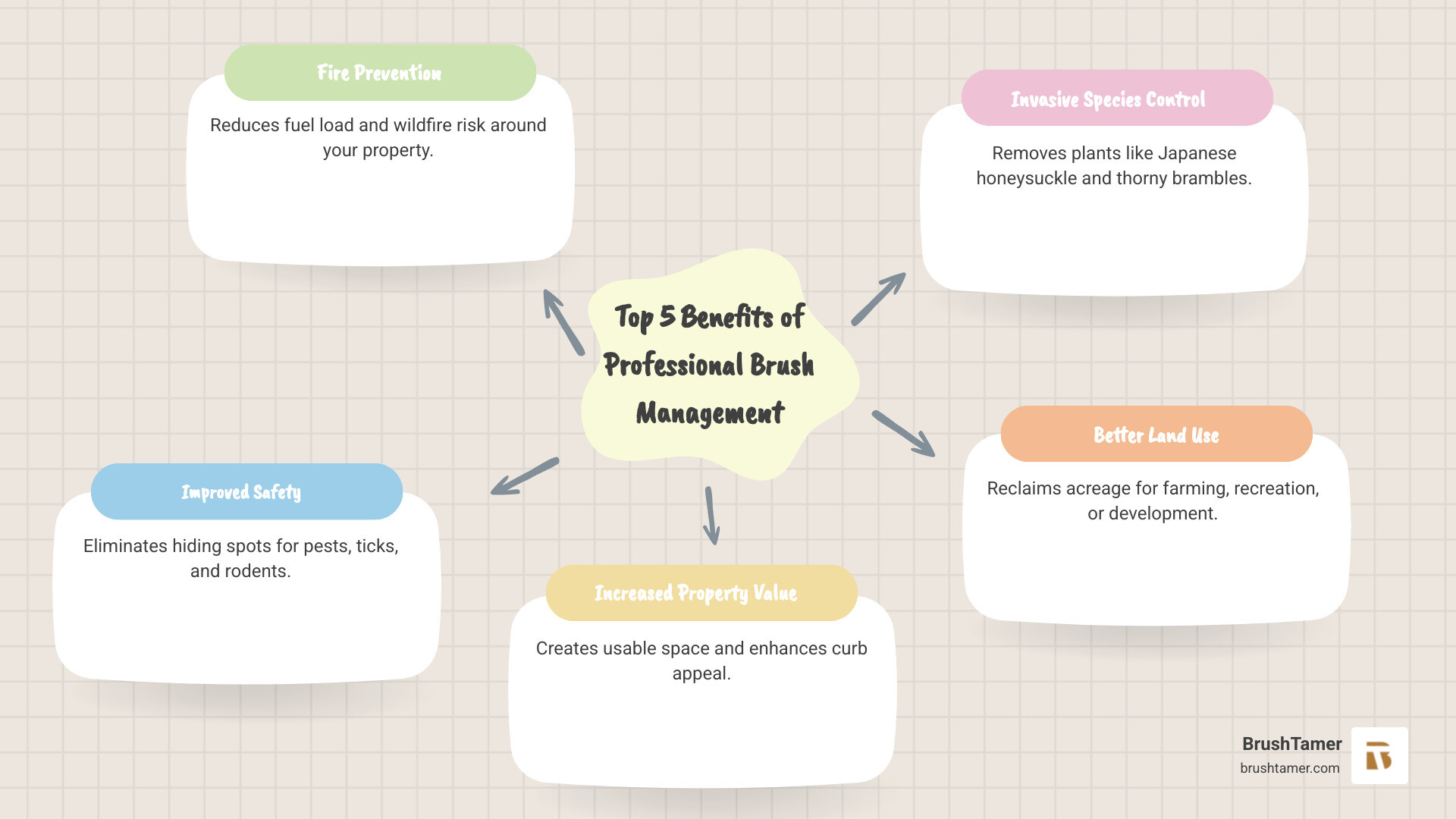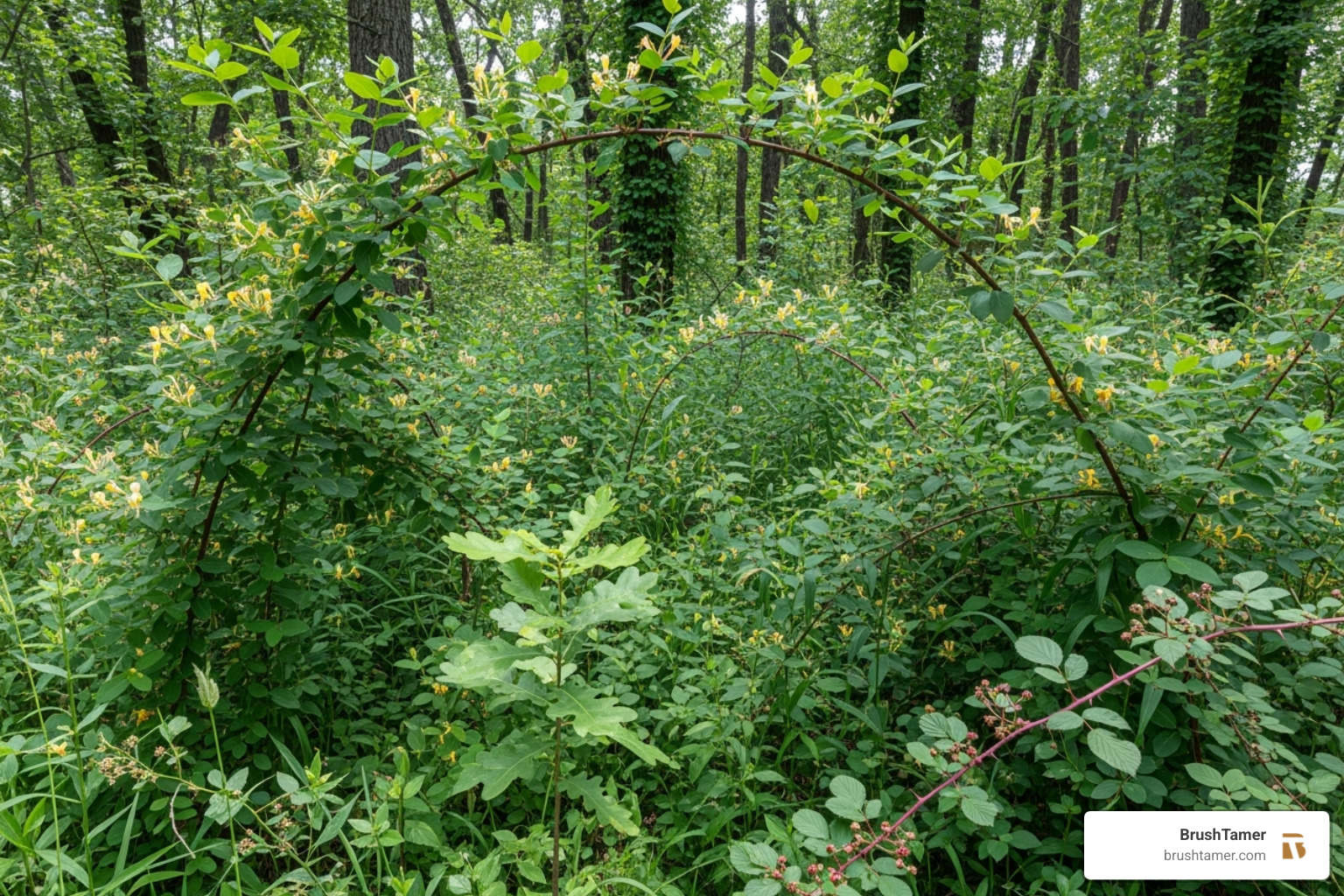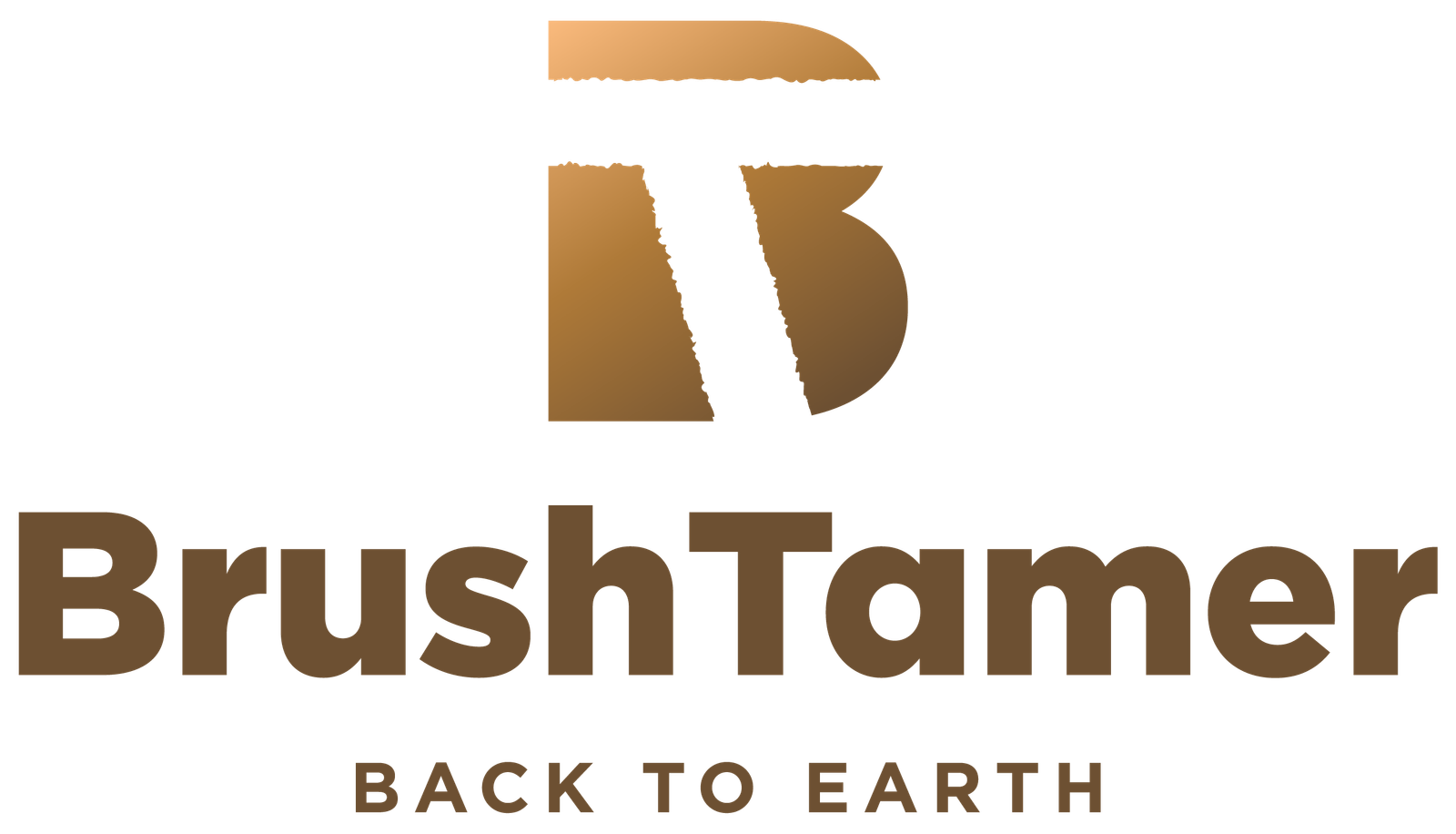Why Brush Management Matters for Your Property
Brush management near me is a professional land-clearing discipline focused on removing overgrown vegetation, invasive species, and hazardous understory to increase safety, usability, and long-term property value. When neglected, brush becomes a liability: it lifts wildfire risk by creating continuous fuel, harbors pests and rodents, impedes access, obscures sightlines, and depresses appraisal values. The solution requires strategic, professionally managed programs that restore ecological balance and turn non-performing acres into productive, attractive assets.
What you can expect from a professional, BrushTamer-led brush management program:
- Fire prevention – strategic fuel-load reduction and defensible space planning around structures
- Improved safety – fewer pest harborage areas and clearer sightlines along driveways, fencelines, and structures
- Increased property value – immediate curb appeal improvements and expansion of usable acreage
- Invasive species control – targeted removal of aggressive plants that outcompete native vegetation
- Better land use – reclaims ground for agricultural, recreational, habitat, or development objectives
Overgrowth is not merely cosmetic. Dense vegetation creates ladder fuels, accelerates fire spread, and compromises emergency access. It also fosters damp microclimates where ticks and rodents thrive, reduces visibility, and blocks access to important assets like fences, wells, and outbuildings. Buyers and appraisers read overgrown brush as deferred maintenance and future expense, often discounting offers accordingly. According to the National Fire Protection Association, proper vegetation management is essential for creating defensible space around structures.
BrushTamer deploys professional-grade equipment and trained operators to deliver selective clearing that aligns with your goals. Techniques such as forestry mulching, targeted grubbing, and post-clear maintenance plans are used to address species composition, slope, soils, and access constraints. Rather than simply cutting vegetation down, we implement a prescription custom to your site that improves soil protection, preserves desirable trees, and sets the stage for durable results.
This guide explains how to evaluate brush management near me, the methods that produce reliable outcomes, regional invasive threats, timing considerations, regulatory factors, budgeting variables, and what to expect when you engage BrushTamer.

The Critical Importance of Professional Brush Management
When property owners search for brush management near me, they are seeking risk reduction as much as aesthetics. The right program lowers fire exposure, reduces liability, and supports long-term asset performance. Underwriters, appraisers, and municipal officials increasingly consider vegetation management when evaluating a site’s safety and value. Professional brush management is, therefore, a strategic property improvement—measured not only in visual transformation but also in lower hazard profiles and better appraisals.
From a risk perspective, overgrown understory creates continuous fuel beds that allow ground fires to climb into canopies and spread rapidly. Professional crews establish defensible space and break up fuel continuity in accordance with local fire-prevention guidance, all while safeguarding desirable trees and soil structure. Visibility around buildings, access drives, fences, and rights-of-way is restored, improving both security and emergency response.
From a financial perspective, reclaimed acreage converts non-productive ground into usable space for pasture, hay, recreation, or future improvements. Market feedback is clear: well-managed land presents better, maintains value, and simplifies due diligence for buyers. Clear, accessible properties reduce the cost and complexity of subsequent improvements—fencing, drainage, outbuildings, and habitat work can be executed more efficiently when brush is under control.
From an ecological perspective, professional brush management is a cornerstone of wildlife habitat improvement. Strategic clearing prioritizes native regeneration, light availability, and soil protection while removing dominant invasives. This unlocks healthier plant communities that support beneficial wildlife and reduce undesirable pest pressure.
BrushTamer’s methods are engineered for environmental responsibility and durable results. Explore our Brush Management Services to see how we tailor strategies for residential, agricultural, and commercial properties, and learn more about our commitment to Environmentally Friendly Land Clearing. As proud members of the Missouri Farm Bureau, we help landowners convert brush-choked acres into stable, productive ground with a clear plan for sustained results.
Identifying Problem Vegetation in Your Local Area
Effective brush management near me begins with a precise understanding of species composition, stand density, and site constraints. A one-size-fits-all plan does not work. BrushTamer conducts on-site inventories to map vegetation types, differentiate invasive and nuisance species from desirable natives, note sensitive areas, and assess access, slope, and soil conditions. That assessment informs a clearing prescription that accomplishes your goals while preserving the site’s long-term health.

Common invasive and nuisance plants we encounter across Midwestern properties include:
- Japanese honeysuckle – a smothering vine that climbs and shades out shrubs and young trees
- Thorny brambles – dense, thorned thickets that restrict access and harbor pests
- Ground ivy – a vigorous groundcover that outcompetes turf and native forbs
- Unwanted saplings – volunteer trees maturing in the wrong place, complicating maintenance and access
- Bush honeysuckle and autumn olive – aggressive shrubs forming impenetrable walls, displacing native understory
- Multiflora rose – a thorny, fast-spreading shrub that overwhelms pastures and fencelines
These plants degrade biodiversity, impede sightlines, and create significant maintenance burdens. BrushTamer’s crews identify the growth patterns and regrowth risks associated with each species and implement removal sequences that reduce the likelihood of rapid re-infestation while protecting desirable vegetation.
Best timing for brush clearing depends on objectives and site conditions. The dormant season (late fall through early spring) typically offers superior visibility, firmer soil conditions, and reduced stress on retained trees. That timing also improves selectivity—operators can more easily differentiate target plants and work efficiently around keeper trees. In some cases, growing-season operations are preferred to disrupt particular species’ growth cycles. Excessively wet conditions are avoided to protect soil structure and prevent rutting.
The outcome is a site-specific plan: strategic clearing, calibrated mulch depth, protection zones for desirable trees, and follow-up maintenance scheduling. BrushTamer aligns all of these decisions with your goals—pasture expansion, recreational access, habitat improvement, development preparation, or a combination thereof—so that the result is both immediate and durable.
A Professional’s Guide to Brush Management Methods
Selecting the right method is the difference between a quick visual change and a durable improvement. Brush management near me requires professional equipment, trained operators, and a site-specific plan that protects soil, preserves desirable trees, and minimizes disruption. BrushTamer deploys a range of techniques matched to your goals, vegetation, and terrain.
What methods are used for brush management near me?
- Forestry mulching – The preferred method for most overgrown sites. A dedicated mulching head reduces brush, vines, and small trees in place, creating a protective layer of organic mulch. It enables exceptional selectivity: BrushTamer can remove targeted vegetation while protecting keeper trees and root zones. The mulch helps control erosion, moderates soil temperatures, and suppresses unwanted regrowth.
- Brush hogging (rotary mowing) – Effective for maintaining previously cleared areas, reclaiming neglected fields with lighter woody growth, and establishing manageable maintenance cycles. It is a strong follow-up tool once dense thickets have been reduced by mulching.
- Selective mechanical clearing – In constrained areas or along sensitive boundaries, BrushTamer uses compact or specialized equipment for precision removal where access or protection zones limit larger machines. This approach allows careful work near fences, utilities, or structures while maintaining project momentum.
BrushTamer’s equipment fleet is matched to your site. Tracked carriers distribute ground pressure to protect soils and steer slopes that would challenge standard mowers. Machine selection, head type, and approach are chosen after a site walk so production, selectivity, and protection remain in balance. Explore our land clearing equipment lineup to see the range of tools we deploy for complex terrain and dense vegetation.
A deep dive into forestry mulching
Forestry mulching has become the gold standard for environmentally conscientious land clearing because it resolves multiple problems at once. The process shreds unwanted vegetation and evenly distributes organic matter across the work zone, producing a uniform mulch layer. The USDA Forest Service recognizes mechanical fuel reduction methods like mulching as effective wildfire prevention strategies. Benefits include:
- Minimal soil disturbance compared to push-and-pile methods
- Immediate erosion control and surface protection from the mulch layer
- Efficient selectivity for saving keeper trees and native shrubs
- No debris piles, no burn permits, and no trucking of cut material
- Faster throughput in dense understory compared to manual cutting and hauling
Where appropriate, BrushTamer calibrates mulch particle size and coverage to balance weed suppression with native regeneration objectives. Our operators work to industry best practices around trunk flare, feeder roots, and dripline protection for retained trees. For constrained sites, our mini forestry mulching services deliver similar advantages in tight spaces. Watch our mini forestry mulching video to see that capability in action. For project types, production expectations, and method fit, review our Forestry Mulching Services page.
Every method we deploy is implemented by BrushTamer crews with professional training and equipment, ensuring your property receives a professional standard of care and a result designed to last.
How to Find the Best Brush Management Near Me
The right partner for brush management near me brings more than a machine—they bring planning discipline, regulatory awareness, safety protocols, and a track record. BrushTamer begins with a consultation and site walk to define objectives, document constraints, and align methods with outcomes. Clear communication and documented scope ensure you understand how the work will be executed before the first machine arrives.

Key questions to ask a brush management professional
- Insurance and safety – Request proof of liability insurance and safety certifications. A reputable contractor issues a certificate of insurance naming you as certificate holder and follows documented safety procedures.
- Method fit – Expect a clear explanation of why forestry mulching, brush hogging, or selective mechanical clearing is recommended for your site, including how keeper trees and sensitive areas will be protected.
- Scope of work and deliverables – Ask for written scope, map or marked boundaries, and performance expectations (e.g., target mulch coverage, access lanes to be opened, specific thickets to remove).
- Site protection – Clarify how utilities, fences, structures, and waterways are safeguarded. Professionals coordinate utility locates, establish stand-off distances, and set protection zones.
- References and results – A strong contractor can show before/after examples, client testimonials, and similar project outcomes.
What are the costs of brush management near me?
No two projects are alike, so investment levels vary. Factors include:
- Vegetation type and density – Dense, woody thickets require more time and more robust equipment than light brush or field grass
- Terrain and soils – Slope, rock, wet pockets, and sensitive soils influence production rates and method choice
- Access and obstacles – Narrow entries, low clearances, utilities, and structures require slower, more selective work
- Project size and staging – Larger projects can improve cost efficiency per acre; multi-phase schedules may be optimal for seasonal or ecological goals
- Mobilization and compliance – Travel, site setup, and regulatory due diligence add time but protect your project from delays and fines
Forestry mulching reduces disposal costs by eliminating haul-off and burn management for the cleared vegetation. For planning considerations and budgeting variables, review our Lot Clearing Guide 2025.
Understanding local regulations and permits
Municipalities and state agencies may regulate clearing near streams, wetlands, steep slopes, utility corridors, and road frontages. Some jurisdictions enforce tree ordinances, buffer protections, or seasonal restrictions to protect habitats. Burning debris typically requires permits and is often restricted. BrushTamer performs due diligence and coordinates with the appropriate authorities to keep your project compliant and on schedule. View our Service Area to confirm coverage in Indiana, Michigan, Illinois, Ohio, and Wisconsin, and to discuss local requirements specific to your parcel.
Frequently Asked Questions About Professional Brush Clearing
Property owners searching for brush management near me often share similar priorities: clear scope, predictable outcomes, and minimal disruption. These answers outline how BrushTamer delivers on those expectations.
What is the difference between brush clearing and land clearing?
Brush clearing focuses on understory vegetation—shrubs, vines, saplings, and thickets—to reclaim access, improve safety, and enhance aesthetics. It is not intended to convert a property into a construction-ready pad. Land clearing, by contrast, removes large trees, stumps, and obstacles to prepare a site for building or major agricultural use. BrushTamer performs both and scopes each project according to the intended end use, from habitat and pasture improvement to development preparation.
How does BrushTamer protect utilities, fences, and structures during clearing?
Before work begins, BrushTamer coordinates utility locates as required, reviews known service lines with the owner, and marks stand-off distances. Operators establish protection zones around structures, wells, septic components, and fence lines. Equipment choice and approach are adapted to each constraint—compact or specialized machinery is used where required to maintain selectivity and safety.
How long will results last, and what maintenance plan is recommended?
The visible transformation is immediate. Longevity depends on site conditions and goals. BrushTamer can establish a maintenance schedule—often seasonal or annual—to keep regrowth in check, maintain access, and reinforce defensible space. For pasture or open-space objectives, periodic brush hogging after initial mulching is a common, efficient follow-up. For habitat-focused projects, maintenance is timed to support native regeneration while suppressing aggressive re-invaders.
What should I expect in terms of scheduling and project duration?
Lead times depend on season and project complexity. After the initial consultation and scope confirmation, BrushTamer provides a proposed start window and a production plan tailored to your site. Duration is driven by acres, density, terrain, and access. Crews maintain steady progress and communicate milestones so you know what areas are completed and what comes next.
Do you serve my location?
BrushTamer serves Indiana, Michigan, Illinois, Ohio, and Wisconsin, with the ability to coordinate projects across the Midwest. Visit our Service Area page to confirm coverage and discuss site-specific requirements.
Reclaim Your Property with Expert Brush Management
Professional brush management near me is the most direct route to a safer, more valuable, and more usable property. With BrushTamer, you get a clear plan, professional execution, and durable results: strategic fuel-load reduction, restored access, invasive species control, and a more resilient landscape.
Our process is straightforward and disciplined: assessment and goals discussion; written scope and method selection; safe, efficient fieldwork by trained operators; and a maintenance plan to keep gains locked in. Every step is managed by BrushTamer so you have a single accountable partner from first conversation to final walkthrough.
Your land is ready to be opened up and put back to work. Contact us today to start the conversation, align on objectives, and schedule a site walk. Explore Brush Management Services for method details and our commitment to Environmentally Friendly Land Clearing for the standards that guide our work. BrushTamer is ready to deliver a professional, lasting transformation of your property.
